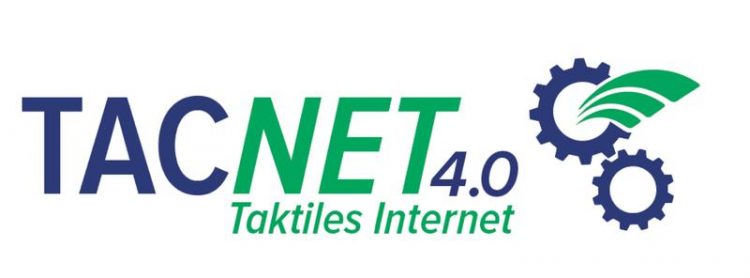TACNET 4.0 – German industry consortium develops system for real time industrial networks

TACNET logo TACNET
Germany is scheduled to launch the 5th generation equipment and infrastructure (5G) in the year 2020. The future network will enable very high data rates and be a so called “tactile internet,” that is to say, it will be capable of reaction times of less than a millisecond that are no longer perceptible for humans.
However, the highest reliability and real time communication required for networked production (Industrie 4.0) will not be supported end-to-end in the first phase. As a contributing partner in the BMBF sponsored program “5G: Tactile Internet,” TACNET 4.0 is developing the required concepts and algorithms and creating the right conditions for many Industrie 4.0 applications such as direct interaction between humans and machines or wireless process controls.
Minimal latency as the basis for various applications
An important aspect of TACNET 4.0 is the secure transfer of data with minimal delay between local and multi-site users, for example, for remote control of equipment. Prof. Dr. Hans Schotten, head of the research department for Intelligent Networks at the German Research Center for Artificial Intelligence (DFKI) in Kaiserslautern and coordinator of TACNET 4.0 explains: “Demanding and, until now, impossible to implement scenarios in process and manufacturing automation will be enabled by innovative 5G technologies.
Such a scenario might be the remote control of mobile equipment or robots that are designed to operate in dangerous environments or the operation requires experts that are not locally available. The project is investigating new approaches like Big Data analytics, Edge-Cloud supported real time control, and remote services.”
Dr. Peter Rost, Nokia Bell Labs, added: “The tactile internet is key to the comprehensive networking of humans and things, as this technology will contribute to added industrial value and facilitate everyday living for people. Nobody is developing the application scenarios of tomorrow in isolation. It takes extensive cooperation among various branches of industry. We are very pleased that we are able, together with our TACNET4.0 partners, to drive this development of the tactile internet.”
Open interfaces guarantee adaptability
The greatest challenge facing TACNET 4.0 is to integrate future 5G networks and other current as well as new industrial communications systems to support a wide range of industrial applications, including the integration of field bus systems. TACNET 4.0 relies on open interfaces, so that network functions can be expanded, for example, through apps. Additionally, initial attempts are being undertaken to use mobile wireless networks for wide area coverage, instead of only the current local wireless sensor networks or WLAN.
14 partners and a 3-year term
In addition to DFKI and Nokia Bell Labs, the TACNET consortium includes ABB Research Center, Ascora GmbH, Robert Bosch, CommSolid, Götting KG, Institute Industrial IT (inIT) of the OWL University of Applied Sciences in Lemgo, MECSware, NXP Semiconductors Germany, OTARIS Interactive Services, University of Dresden (Vodafone Chair of Mobile Communication Systems and the Deutsche Telekom Chair of Communication Networks), University of Bremen as well as associated partners: BASF, Busch-Jaeger, Hirschmann Automation and Control, Innoroute, Phoenix Contact Electronics, Vodafone Germany, VDMA (Mechanical Engineering Industry Association), and it’s OWL (it’s OWL stands for Intelligent Technical Systems OstWestfalenLippe).
DFKI (Prof. Dr. Hans D. Schotten) and Nokia Bell Labs (Dr. Peter Rost) are jointly responsible for project management. The Federal Ministry of Education and Research (BMBF) officially launched the project with approximately 6.3 million euros in April 2017. The project term is three years.
On November 30, 2017, a consortium meeting on the first project milestone took place in Munich. With this, the analysis of the use cases and industry requirements has been completed and integrated into the 3GPP standardization, so that now the actual work in the technical working groups and the preparation of demonstrators can be tackled.
Contact:
Prof. Dr.-Ing. Hans Schotten
Research department: Intelligent Networks
German Research Center for Artificial Intelligence (DFKI)
Trippstadter Straße 122
67663 Kaiserslautern
E-Mail: hans_dieter.schotten@dfki.de
Tel.: +49 173 3889470
Dr. Peter Rost
Nokia Bell Labs
Werinherstr. 91, 81541 Munich, Germany
E-Mail: peter.m.rost@nokia-bell-labs.com
Tel: +49 171 8677780
DFKI Press contact:
Corporate Communications Team
German Research Center for Artificial Intelligence (DFKI)
Trippstadter Straße 122
67663 Kaiserslautern
Tel.: +49631 20575 -1700/1710
E-Mail: uk-kl@dfki.de
Press Contact Nokia Bell Labs:
Martina Grueger-Buehs
E-Mail: martina.grueger-buehs@nokia.com
Tel: +49 160 74 36 22
Bernhard Fuckert
E-Mail: bernhard.fuckert@nokia.com
Tel: +49 162 28 36 967
http://www.tacnet40.de project website
http://www.forschung-it-sicherheit-kommunikationssysteme.de/projekte/tacnet project website BMBF
http://www.dfki.de/in DFKI Intelligent Networks
Media Contact
All latest news from the category: Information Technology
Here you can find a summary of innovations in the fields of information and data processing and up-to-date developments on IT equipment and hardware.
This area covers topics such as IT services, IT architectures, IT management and telecommunications.
Newest articles

NASA: Mystery of life’s handedness deepens
The mystery of why life uses molecules with specific orientations has deepened with a NASA-funded discovery that RNA — a key molecule thought to have potentially held the instructions for…

What are the effects of historic lithium mining on water quality?
Study reveals low levels of common contaminants but high levels of other elements in waters associated with an abandoned lithium mine. Lithium ore and mining waste from a historic lithium…

Quantum-inspired design boosts efficiency of heat-to-electricity conversion
Rice engineers take unconventional route to improving thermophotovoltaic systems. Researchers at Rice University have found a new way to improve a key element of thermophotovoltaic (TPV) systems, which convert heat…



